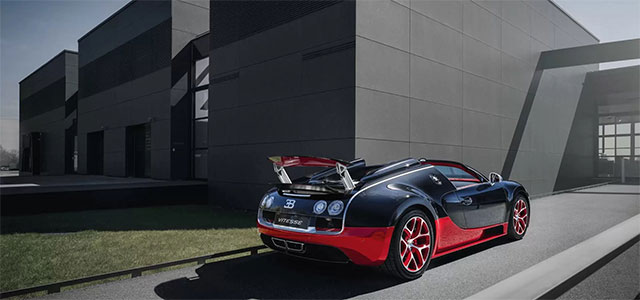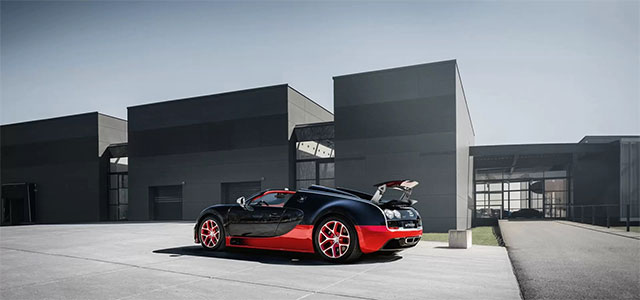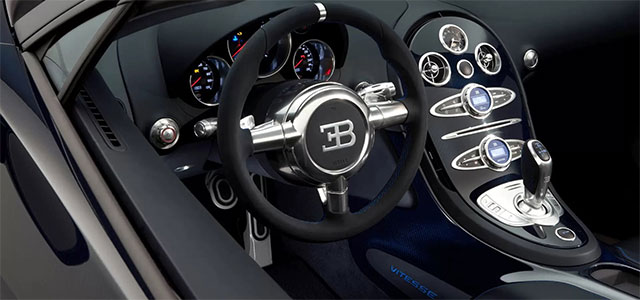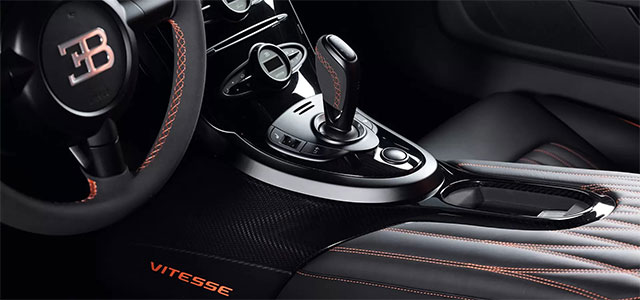Unveiled initially as a concept at the 1999 Tokyo Motor Show, the Veyron materialized as a demonstration of Volkswagen AG’s prowess rather than just a mere car, showcasing its engineering might by crafting one of the most exceptional road vehicles globally.
Volkswagen’s attainment of the Bugatti brand in 1998 led to the birth of a series of extravagant concepts – the EB 118, EB 218, and the more familiar 18/3 Chiron – all featuring a proposed 6.3-liter, 545bhp W18 engine. Among them, the 18/3 Chiron offered the public a preliminary view of the Veyron, which later evolved from the 16/4 Veyron concept into the final production masterpiece. Bugatti introduced multiple iterations of the Veyron, with the Super Sport emerging as the pinnacle of speed. This Bugatti Veyron top speed (from three runs) at Volkswagen’s Ehra-Lessien test track was 268 mph (431 km/h), which enabled it to register its name in Guinness World Record.
The Bugatti Veyron top speed during its initial outing was 270 mph (434 km/h). Merely 48 units of the Super Sport were manufactured, and the available vehicles for purchase were capped at 258 mph (415 km/h), costing $2.4 million.
Table of Contents
Bugatti Veyron Top Speed History
Bugatti emerged within the last few decades in its current recognizable form, establishing itself in the wake of the Volkswagen Group’s involvement in 1998. Yet, the roots of this prestigious legacy extend far beyond this recent phase, tracing back an astonishing 111 years to 1909. During that time, visionaries Jean and Ettore Bugatti took the helm and introduced the iconic badge.
The brand exhibited initial brilliance, crafting machines engineered for both the road and the racetrack, surpassing the capabilities of the majority of contemporary automobiles. A striking testament to this prowess occurred in 1929, as William Grover-Williams clinched victory in the inaugural Monaco Grand Prix aboard a Bugatti Type 35B. Notably, Bugatti also clinched triumph in two editions of Le Mans.
However, this era of splendor was regrettably brief, concluding in 1952 due to financial turmoil compounded by the tragic demise of the company’s founders, Ettore and Jean Bugatti. Subsequent years encompassed endeavors at revival and even aircraft component production until 1987 when Italian entrepreneur Romano Artioli acquired the marque.
A pivotal moment emerged in 1990 with the inauguration of the renowned Modena facility, perfectly timed for the commencement of EB110 GT manufacturing. Despite a satisfactory stint of accomplishments with the supercar, fiscal challenges once again precipitated cessation in 1995, preceding the Volkswagen Group’s acquisition and the ensuing renaissance of the brand in 1998.
Bugatti officially announced the production of its W16-powered supercar in 2001, approximately six years after concluding the manufacturing of the EB110. The premier customer vehicle emerged from the Molsheim production facility in 2005, and a total of 450 units were crafted from that point until the cessation of production in 2015, a span of ten years. The initial price point stood at $1.9 Million.
On April 2005, test driver Uwe Novacki attempted the Bugatti Veyron top speed run. The objective involved surpassing the 249 mph (400 km/h) threshold, an achievement previously unattained by any mass-produced automobile. Triumphantly, the Bugatti Veyron soared to 253 mph (407 km/h), establishing a zenith that other automakers would then aspire to conquer. Ever since Bugatti has become synonymous with velocity, and the remainder, as tradition dictates, resides within the archives of time.
Bugatti Veyron Design & Styling
The Veyron stands as a testament to engineering finesse, diverging from Monet’s artistic strokes. Hence, it’s hardly a disservice to label the Veyron candidly: a peculiar, insect-esque contraption with a set of four oversized tires, an extravagant array of intakes and winglets adorning its sides and roof, and proudly bearing a unique white-and-red emblem on its front, displaying the word ‘Bugatti.’
On its rear, the letters E and B find their place. Resting atop the uncovered engine, exposed to the air for cooling purposes, reside the numerals 16 and four: 16 cylinders and four turbochargers in total.
Just in case you were inquisitive, these figures translate to a standard output of 987bhp and 922 lb-ft. The true allure of the Veyron lies in numbers like these, emanating from its 8.0-liter W16 powerplant (the W configuration implies, in essence, two 4.0-liter V8s linked to a shared crankshaft).
Introducing a new iteration of the Veyron involves more than just boosting power or removing the roof. The Super Sport, the fastest variant of this already fast car, essentially stands as an entirely fresh creation, with every moving component undergoing a revamp compared to the standard 16.4 model.
Beyond heightened power and torque (now up to 1183bhp and 922 lb-ft), the car showcases supplementary cooling vents beneath the front lights and through its expansive NACA channels on the roof. The A-pillars are slimmer than those on the original Veyron, markedly enhancing rearward visibility—an essential feature when you’re cruising north of 250mph.
The Grand Sport and Grand Sport Vitesse convertible models forgo conventional fixed tops, instead embracing transparent polycarbonate modules weighing a mere 19kg. These units can be attached or detached by pressing two release buttons, but regrettably can’t be stored within the vehicle. This limitation has prompted Bugatti to integrate an emergency carbon fiber soft top, conveniently stowable in the trunk and operational at speeds up to 99mph in case of rain.
Bugatti Veyron Interior
As you step into the Bugatti Veyron, there’s no need for elaborate physical maneuvers, unlike many other so-called supercars.
Gently pull the meticulously crafted aluminum door handle, swing open the door expansively, and, after smoothly navigating the somewhat elevated, substantial sill, effortlessly settle into the seat. The seat, fashioned from carbon fiber and cloaked in thick leather, creates an unparalleled car interior.
Undoubtedly, this stands as the most exquisite automotive cabin globally, despite the initially intimidating ultra-low driving position and the notably thick A-pillars in the standard model that result in significant blind spots.
Your attention is immediately drawn to the elegantly designed center console, hewn from a solitary piece of aluminum. In the case of the convertible Grand Sport Vitesse, an even more intricate console graces the space, crafted from carbon fiber and titanium, undoubtedly incurring several times the expense.
Additionally, the Vitesse boasts a spoiler mounted on the windshield, ensuring that the driver and passenger emerge just as perfectly groomed as when they embarked on their journey.
While situated behind the wheel, the gauges might strike you as small and intricately detailed, particularly the speedometer, yet the overall aesthetic is nothing short of sensational.
Remarkably, the rear-view mirror doubles as the display for the reversing camera, a location increasingly favored but more commonly found in family hatchbacks.
Stash space within the petite front-mounted trunk is notably confined, to put it mildly, yet the interior cabin generously accommodates occupants of this two-seater, mid-engined automobile.
Bugatti Veyron Engine and transmission
Although initial ideas showcased a W18 engine with three banks, the production Veyron actually houses an 8.0-liter W16 engine with quad-turbocharging beneath its surface. This powerhouse features four sets of four cylinders, delivering an output that almost touches 1000bhp, accompanied by 922 lb-ft of torque and performance metrics that left many struggling to compete.
In 2005, the Ehra-Lessien test track of the Volkswagen Group witnessed the Veyron’s top speed hitting 253.81mph. The standard Veyron 16.4 achieved this feat easily with the help of the model’s ‘speed key,’ removing the standard 213mph speed regulator. Bugatti’s experts integrated ten radiators and many cooling components to maintain safe operating temperatures for the powertrain. This particular version of the Veyron recaptured the title of the world’s fastest road-legal car from the McLaren F1.
The task of transferring power to the road falls to a seven-speed dual-clutch automatic transmission from Ricardo of England. Remarkably, this transmission can shift gears in an astonishing 150 milliseconds, faster than the track-oriented Ferrari FXX Evo’s 160 milliseconds from the same era.
However, a top speed of 253mph wasn’t deemed sufficient. Consequently, the Super Sport variant was introduced in 2010. Equipped with larger turbochargers, more efficient inlet manifolds, a recalibrated ECU, and enhanced charge-coolers, this version achieved a power boost of nearly 200bhp compared to the “regular” model, resulting in a total of 1183bhp. Engineers believed the engine could extract more power, but the gearbox wasn’t deemed suitable for the added strain.
Bugatti Veyron Suspension, steering, and brakes
Having such power necessitates an equally potent braking setup. Thus, the Veyron sports 400mm carbon ceramic front discs and 380mm rear discs, coupled with front eight-pot and rear six-pot AP Racing calipers. Complementing the conventional brakes, an air brake swiftly transitions from 15 to 55 degrees of attack in less than 0.4 seconds.
The Veyron’s dual-wishbone suspension system, both front, and rear, features a rapid-response hydraulic mechanism, enabling the vehicle to adjust its ride height depending on the situation, enhancing stability, efficiency, and functionality.
The tires are equally remarkable, custom-crafted by Michelin for the Veyron to handle the immense forces experienced during the Bugatti Veyron top speed run of 250mph+. Boosting stability and traction, the rear tires measure 365mm in width, while the front ones are 265mm wide. These tires hug polished OZ wheels perfectly.
















